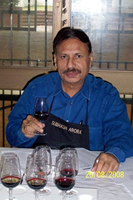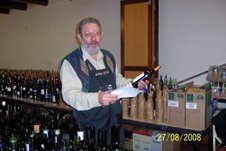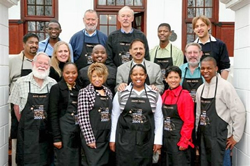 A panel of 12 judges including three foreigners congregated at the famous Hotel Grand Roche last month for three days to taste about 900 South African wines at the historical Nederburg winery in Paarl, the seat of the world famous Nederburg Auction. A panel of 12 judges including three foreigners congregated at the famous Hotel Grand Roche last month for three days to taste about 900 South African wines at the historical Nederburg winery in Paarl, the seat of the world famous Nederburg Auction.
Wines were short-listed from the awarded wines at this tasting. The SAA is now in the process of procuring wines to be placed on board all the airline's flights for premium and economy class customers for 2009.
The foreign judges were Tony Devitt from Australia, Andreas Seidl from Germany and Subhash Arora from India. Yegas Naidoo, Dave Hughes, Nomonde Khubeka, Carmen Stevens, Duimpie Bayly, Luvo Ntezo, Susan Wessels and Thato Goimane represented South African winemakers, sommeliers and judges.
As a policy, SAA buys and serves only South African wines aboard its planes except Champagne which is served in the premium class and is excluded in the selection process. It is the second largest single customer of South African wines in the country, shopping annually for 22-25m R (about $3.5m) which gives it a great bargaining power and also a booster shot to the South African wine industry.
"It is a great privilege for SAA to have the opportunity to recognise and promote the South African wine industry which has contributed significantly towards the country's economy," says Nomvula Nkabinde, SAA Acting GM Sales and Marketing, adding, "SAA customers can be assured they will be offered only best of local produce when flying with us as we have complete confidence in the panel's choice.
 |
| Bennie Howard at his job-behind the Tasting Room |
The judging was a rigorous two- and-a-half-day process of blind tasting, carefully monitored by independent auditors, Deloitte and Touche. The logistical process for the tasting was run very efficiently by the wine consultant Bennie Howard who has been doing it for many years.
Judges were divided into two panels and scored wines from the 750ml bottles in various categories using the 100-point system. The auditors compiled the scores identifying the top scoring wines in each category, which went into the third day's tasting. On the final day, all 750ml wines in the final round were tasted again by the whole jury as one panel. Based on their scores, the auditors established a final ranking for each category.
The other categories of Port, Method Cap Classique and 187ml wines (for economy class) were tasted and scored on the same basis. A total of about 180 wines were tasted on each of the first two days by each judge. The final morning saw about 55 wines tasted. All wines were then kept out in the open for special invitees including winemakers, journalists and producers to taste. The panel of judges was also introduced to the press for their impressions about the competition and the wine quality.
Wine estates with the top wines selected will be awarded at an annual SAA Wine Awards ceremony in November.
The Trophies are awarded for Best Red Wine, Best White Wine, Best Port and Best Method Cap Classique (MCC- refers to SA sparkling wines using the Champagne method of second fermentation).
The competition deviates from the other international competitions in some ways and is more practical in its approach making the seeming impossible task of tasting about 435 wines by each judge in 2.6 days. The wines to be selected must not be too acidic, too tannic and must be best drunk by 2009. If a wine is of excellent quality but will mature in 3-5 years, it does not meet the criteria for the airline selection.
By default, the wines need to be more rounded, luscious and easier to drink and be ready to give their best next year.
A surprising feature was a lack of enthusiasm on the part of producers in submitting the entries for economy class wines-known as 187 category. It is as difficult for the airline to ensure that the wines tasted (some were still in the tanks or barrels) and bottled in small bottles would maintain the same quality as tasted by the judges, as for the producers to offer.
In general, the white Chenin Blancs were of very good quality whereas the Chardonnays tasted a bit oaked on the higher side. Sauvignon and Semillon were delicious whereas the Pinotage most difficult to judge as they were extremely uniform in quality.
 |
| Jury with a few of the organisers from SAA |
The biggest surprise was the Merlots which are generally accepted as of mediocre quality from South Africa but of late, have been improving. I found particularly fascinating those matured in toasted oak. Shiraz was another exception-the quality is ready to take on Australia (as was also confirmed later at Mundusvini wine competition in Germany last week where sample after sample of red wine was scoring high on my jury panel. It was only after the tasting that we discovered that the flight was that of South African Shiraz).
Less surprising was the fact that South Africans in general (not only wine producers) are very passionate about their own wines. Even when they are critical, they are less uncharitable than some in India. Another factor was the mind-boggling variety of wines available. Normally one would take cudgel against selecting wines from a single country but the wines selected would provide enough variety and choice for SAA to have a different set of wines to choose from,
month after month and even the most frequent flyer customers of the airline, like Yegas Naidoo holding the Voyager platinum Status would find no reasons to complain.
Subhash Arora |